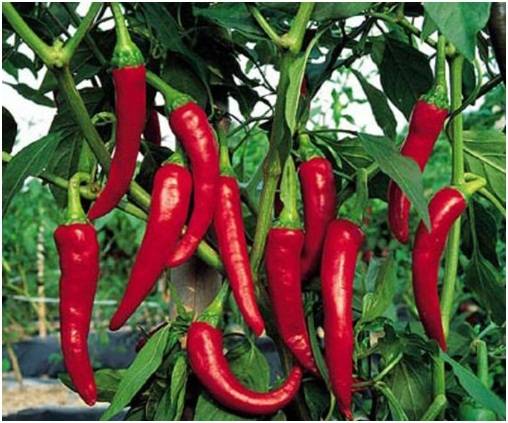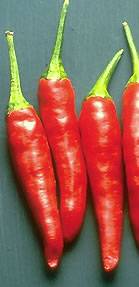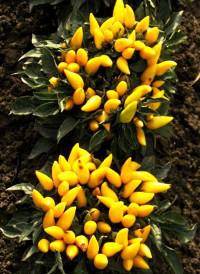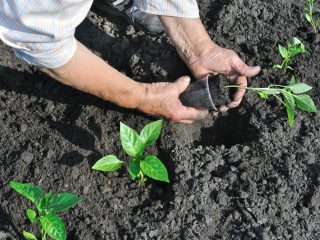Content
All hot pepper varieties, existing in the world today, trace their origins to the wild ancestors of tropical America. The tropical zone covers Central and almost all of South America. It is believed that dishes prepared with hot pepper warm and tone. The American Indians used hot peppers as an anthelmintic.
You shouldn’t immediately rush to use “Indian traditional medicine.” Natural selection acts not only on animals, but also on people. Just as over centuries of drinking fermented products (wine), white people were able to gain increased resistance to alcohol, so the gastrointestinal tract of South American Indians, as well as their pancreas, probably have increased resistance to capsaicin: the pungent substance contained in hot peppers. Today's American worms, by the way, are also probably resistant to dishes containing this seasoning.
Therefore, it is worth listening to doctors who say that excessive consumption of hot peppers is harmful to the stomach.
During the spread of hot peppers throughout the world, many varieties of this plant with varying degrees of hotness were developed.
Scoville scale
To organize plants, seasonings and pure chemicals by degree of pungency, the chemist Scoville proposed "Hotness scale", according to which today the quantitative content of capsaicin in the product is assessed.
On this scale, in last place is the bell pepper, which has zero Scoville Units (SSU). Resiniferatoxin is in first place, which is not related to peppers (found in two types of euphorbia) and is a toxic substance, but has 16 billion units on a scale. All hot peppers fall between these two positions.
According to this scale today The hottest type of pepper is the Carolina Reaper., which broke the Trinidadian scorpion record in 2013. The heat of the “Carolina Reaper” can reach up to 2.2 million ECU.
The Carolina Reaper is used for medical and military purposes.
In second place is Scorpio Trinidad Moruga Blend., having from 1.2 million to 2 million ECU.
Trinidad Scorpion Moruga Blend
A recently bred variety that broke the record of its predecessor Trinidad Scorpion Butch T in 2012 and is now in second place. The pepper got its name “scorpion” from its small tail. “Trinidadian”, because it was on the island of Trinidad that these varieties were bred.
When growing and processing such hot plants, it is necessary to wear chemical protective suits and gas masks. It is used not as a spice, but to produce tear gases and paint that protects the bottom of a ship from shellfish.
Third place divided into two varieties. Trinidad Scorpion Butch T - a relative of the record holder, also native to Trinidad and grown for the same purposes as Moruga. Its pungency reaches 1.9 million units.
Naga Jolokia - a natural hybrid that appeared in India. Its second name is “pepper - ghost”. In terms of the degree of pungency, it is practically not inferior to Trinidad scorpions.
Apart from industry, these varieties are of interest only to fans of the competition “who can swallow the most hot peppers in the shortest period of time.” Less hot vegetables are used for food. Although Jolokia varieties are used to make sauce, it is minimally added to dishes in minimal quantities.
Among the “edible” varieties of hot peppers, Habanero peppers come first in terms of heat. The most burning among them is “Red Savina”.
Those who wish to try a dish with this pepper first sign a waiver of claims regarding the consequences of tasting.
If you need not only spicy, but also decorative pepper for growing at home, you can choose Chinese ornamental five-color pepper.
During the ripening process, the fruits change color. This also helps determine the degree of ripeness of the fruit, since the harvest is unfriendly. When ripe, the fruit changes color from purple to red.
For some reason, the word “purple” is usually associated with the red spectrum, but it is actually the violet spectrum of colors.
Hot pepper. On the scale, its pungency is 30 - 60 thousand units. For comparison, the heat of classic Tobasco sauce is only 2.5 -5 thousand.
On the heat scale, this pepper is on a par with the Cayenne group and, most likely, is also included in this group.The fact is that “Cayenne pepper” is not a variety, but a group of varieties of hot pepper. Another name for this group of varieties is “Chile”. Today, the term "chili" applies to all hot varieties of pepper.
Since after the first three varieties of raw materials for poisonous gases edible peppers begin, lovers of spicy dishes can already choose for themselves the best varieties of hot peppers that they would like to grow on their site or even in their apartment.
Hot and semi-hot peppers
Acute varieties include varieties with 7 thousand to 5 million Scoville units. The number of spicy varieties includes such well-known ones as the Habanero group, the Cayenne group, and the Thai group.
"Cayenne"
Often the name “Cayenne” refers to the rather large, long fruits of red capsicum, which are well known to all residents of the post-Soviet space. It actually has a fairly low degree of pungency.
It is from these varieties that the spice of the same name is produced. The fruits are well dried, seeds and veins are removed, and the pulp is ground into powder.
The shape of fruits in the Cayenne group can vary from long to spherical, size from large to small. The color of ripe fruits can be red, white, black, purple, yellow. Unripe fruits are purple or green.
The only common symptom: the pericarp contains little moisture.
“Chili” today is the name for almost any pepper hotter than a bell pepper, so semi-hot pepper varieties are often included in this group.
TO semi-sharp refer to those having a non-zero number of units.Actually, only sweet bell peppers do not contain capsaic and are neither semi-hot nor hot.
Anaheim
It is one of the semi-sharp ones.
This is a large variety of pepper that can be used for grilling or stuffing. The fruits of this variety can be red or green. Both options can be eaten. At the same time, green is less pungent, but it has a richer chemical composition.
Can be stored in the refrigerator for a week. For longer storage it must be frozen.
Ways to use hot peppers
Small fresh pods are fried in a frying pan until softened. First, if necessary, you need to remove seeds and veins. If the skin of the pepper is too thick, remove it too.
Larger ones can be baked in the oven over high heat or scorched on a gas burner until black. Purpose of manipulation: remove the skin.
The storage method depends to some extent on the size of the fruit.
Freezing
Fried pods are subjected to the procedure. If you need to freeze fresh ones, they are first dipped in boiling water for three minutes, then cooled and frozen. There is no need to remove the skin from frozen peppers; it will come off on its own during thawing.
Drying
Peppers are dried in the sun, which causes the pods to become more saturated in color and wrinkle. Dried pepper is most often ground into powder after removing the calyx. If desired, you can put the whole thing in a dish.
In addition to preparing the powder, dried peppers are strung on a rope and the pepper bundles are hung from the ceiling, thus preserving it for the winter.
Soak
There is another little-known way to preserve small hot peppers with a high degree of heat. The pods are placed in a jar with a screw-on lid and filled with water. Very quickly the water is saturated with capsaicin released from the seeds. As a result, not a single bacterium survives in such an environment.
All this is good, but the gardener is primarily concerned with which variety of hot pepper to choose for growing it in the garden. And he is more concerned about the yield and adaptability of pepper to the conditions of the region, and not about its pungency. Burnt tongue receptors are unlikely to be able to distinguish the taste of Habanero from Tobasco.
The most productive varieties of hot peppers. With photo
Ogonyok
It is so well known in the post-Soviet space that its name is already becoming a common noun, like the name “chili”.
This is a plant with long, large, classically shaped fruits. The weight of the fruit is thirty to forty-five grams, and the yield reaches three kilograms per square meter in an open garden bed, which is very significant when you consider the amount of product consumed at a time. In a greenhouse, bushes can produce almost four kilograms of fruit per meter.
The variety is mid-season, the bush is forty-five to fifty-five centimeters high. Resistant to common diseases.
Tonus 9908024
Another time-tested high-yielding variety.
Mid-early. The fruit is large, long, weighing fifteen grams. The average yield is three and a half kilograms. The fruits can be collected both mature (red) and at the stage of technical ripeness, i.e. still green. This variety has a special feature: downward-pointing fruits and slightly wrinkled leaves. Resistant to many viral diseases.
Pepper is considered a southern plant, so there is a belief that in the northern regions it can only grow in a greenhouse. In Siberia, and even more so, it began to be grown only forty-five years ago. Accordingly, Russian gardeners do not seek to allocate acreage for this crop. But in vain. There are already varieties bred for cultivation in open ground in Russia.
Astrakhansky 147
An old variety, still known in the Soviet Union. Created and zoned for the southern regions of the Union in Volgograd in forty-three. It produces about thirty very small and hot fruits. The pepper does not weigh more than twenty-four grams.
Astrakhansky 628
This is a completely different variety, created in Maykop, but also intended for cultivation in the south. The pepper of this variety weighs only fourteen grams. Often these two varieties are confused, which explains the different size of the fruits of the supposedly same variety.
Elephant trunk 304
Trans-Ural residents should pay attention to it. Also the brainchild of the Maikop station. The variety is intended for cultivation in the Far East. A distinctive feature is the presence of purple pigment. The pepper bush has a purple-brown color in the internodes.
The variety is mid-season. Refers to semi-sharp. The fruit is long, cone-shaped, somewhat curved. Length up to nineteen centimeters and weighing up to twenty-five grams. Productivity is up to one and a half kilograms per square meter.
Decorative varieties are gaining popularity. These are perennial evergreens bushes, capable of growing in low light conditions.
For example, “Goldfinger” is not edible according to all sources, but information about “Filius Blue” varies. It’s better not to take risks and eat varieties bred for cooking.
Decorative variety “Queen of Spades”
The bush is spherical. Fully ripened fruits are red, unripe ones are purple.
Filius blue
The pepper has an interesting purple color. Fruits abundantly. The fruits have a very pungent taste. But the edibility of this variety is questionable.
Goldfinger
A beautiful and original-looking variety, but, alas, the fruits are not edible.
Rowanushka
The fruit is round, up to two and a half centimeters in diameter. Used to make paprika.
Conclusion
It seems to a novice gardener that varieties of hot peppers very little. Often, in general, people only know one. But if you take a closer look, your eyes will widen at the abundance of varieties of hot peppers.



























